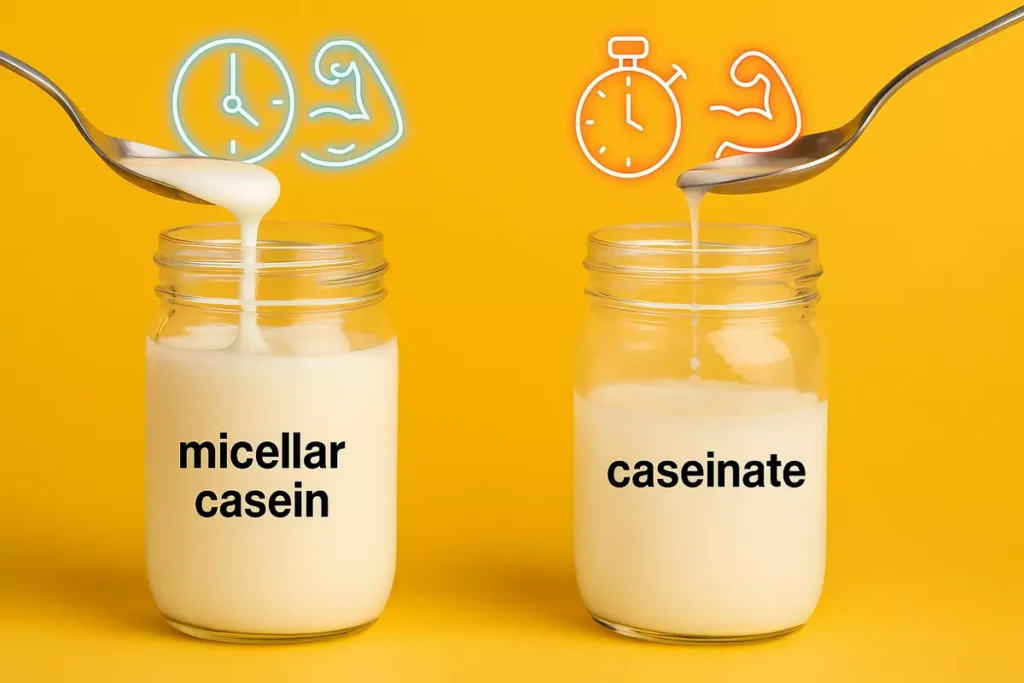If you’re serious about muscle recovery and long-lasting gains, micellar casein might be your game-changer.
Unlike fast-digesting proteins that burn out in hours, micellar casein works through the night—fueling muscles while you sleep.
This article breaks down what makes micellar casein superior, how it compares to other casein types, and why I recommend it to clients cutting, bulking, or struggling with late-night hunger.
Real-world results, personal insights, and science-backed benefits—all in one place.
Table of contents
What Makes Micellar Casein Better Than Other Types?

Let’s not waste time—micellar casein is the king of slow-digesting proteins, and I’ve learned that firsthand.
Unlike other forms of casein that are processed or altered, micellar casein maintains its natural structure, forming tiny clusters (micelles) that take longer to break down in your stomach.
This means it drip-feeds your muscles with amino acids for up to 7 hours—perfect for overnight recovery. That’s why it’s a go-to in my late-night nutrition strategy.
Personally, I started using micellar casein seven years ago during a strict cutting phase. I trained in the evenings, fasted until late morning, and needed something that would keep my muscles fueled while I slept.
A friend of mine from the gym, Carlos from Brazil, swore by it—and he was right. The results were noticeable within a week.
For more on how it works overnight, check out my guide to casein protein before bed.
Micellar Casein vs. Caseinate: What’s the Real Difference?
Micellar casein and caseinate are both milk-derived proteins—but they’re far from equal.
Micellar casein is intact and unaltered, which allows it to digest slowly and steadily.
On the other hand, calcium caseinate is chemically modified for mixability. While it might dissolve faster, it sacrifices the extended-release effect and sometimes causes bloating.
I’ve tested both in my own diet. Calcium caseinate left me feeling gassy and didn’t keep me full as long. Micellar casein felt smoother and more effective at keeping me in an anabolic state through the night.
Want a real food comparison? Read my article on casein vs cottage cheese before bed to see how they stack up.
Muscle-Building Benefits of Micellar Casein

The most obvious benefit? Long-lasting anti-catabolic protection.
Micellar casein is perfect when your body is vulnerable to muscle breakdown—like during sleep or intermittent fasting windows.
It helps preserve lean tissue, improves nitrogen retention, and keeps you full for hours.
I remember a brutal leg day that ended with high-rep Bulgarian split squats. Normally, I’d wake up limping. But after adding micellar casein before bed, I noticed less soreness and better morning recovery.
If you’re fasting, check out this casein + intermittent fasting guide for smart ways to use it.
When and How to Use Micellar Casein
The best time to take micellar casein? Right before bed.
That’s when your body needs steady amino acid delivery the most. I usually go for 30g mixed with almond milk and a little stevia.
Sometimes I even make a thick protein pudding with cocoa and peanut butter. It feels like dessert—but fits my macros.
It’s also a lifesaver during long gaps between meals. Once, I had a flight from Istanbul to Berlin with limited food options. I packed a shaker with micellar casein powder, added water during my layover, and it kept me full and recovered until I could eat again.
If you struggle with mixing casein without clumps, check out this casein mixing guide—it’ll save your shakers.
Who Should Use Micellar Casein?

If you’re serious about your fitness—cutting, bulking, or maintaining muscle—micellar casein has a place in your plan.
One of my online clients, Marcus from Sweden, had a habit of late-night snacking. After I suggested micellar casein, his cravings disappeared within a week.
Another client, Leila from the UAE, was prepping for a bikini competition. She told me it helped her stay full and preserve muscle even in a calorie deficit.
It’s also great for shift workers, students, or anyone who can’t eat often. If you’re concerned about digestion, here’s my guide to casein for lactose-intolerant users.
Final Verdict: Is Micellar Casein Worth It?
Absolutely.
In my experience, micellar casein is the most effective slow-digesting protein out there. It outperforms caseinates in purity, digestion time, and recovery support.
I usually stick with Optimum Nutrition’s Gold Standard Casein—it mixes clean and sits well on my stomach. I’ve also used the unflavored micellar casein from MyProtein when I want to make my own pudding or smoothie.
If you’re trying it for the first time, start with 25–30 grams before bed. Give it a week, and you’ll likely feel the difference—less soreness, more satiety, better recovery.
Thinking of using casein earlier in the day? Here’s a quick read on using casein protein in the morning.
Also, stay informed about potential side effects of casein—so you know what to expect.
Bottom line: If you want steady muscle support and better nighttime recovery, micellar casein is a smart investment. It’s quiet, consistent, and incredibly effective.



Leave a Reply